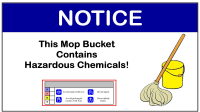We are trying to secondary container labeling plan updated. How strict do I need to be? Do I need to label the mop bucket too?
Although it makes sense that chemical containers should be labeled in the workplace, we often overlook this "common-sense” because of familiarity with the chemical and the bottle. Spray bottles of table wash, disinfectant, or alcohol can easily be mistaken for something else so they must still be labeled to avoid confusion, It’s not appropriate to rely on the staff member’s discretion to tell the difference between a weak solution of chlorhexidine and light blue window cleaner.
When products are received from the distributor or manufacturer, there should be a factory-applied label on the container. It is not necessary to apply additional labels to this container once it reaches the hospital provided that label remains intact and readable.
Since we often purchase materials in bulk supplies, it is usually necessary to transfer the chemical from the original container to another one for use. This is known as a secondary container. It is crucial that EVERY secondary container be labeled, regardless of it’s size or the severity of the chemical it contains.
If the person who fills the secondary container is the only person who will use the product AND the entire contents of the secondary container will be used during that person's work day, then there is no special requirements for labeling; that worker knows what chemical is in the container and has read the original container's label.
If the secondary container will be used by someone other than the person who filled it, or it will be used over several work days, then a label must be placed on the container.
Whatever labeling system is chosen, it must be uniform throughout the practice; this simplicity is easier to explain in the written plan and easier for staff members to understand. It also gives the impression of consistency to the whole program. Likewise, resist the temptation to use the same hazardous materials labels on containers of non-hazardous materials. Bottles of saline or distilled water should be labeled, but don’t use the hazard materials labels because it will cause confusion.
The information contained on the secondary container label must:
- identify the chemical contents and
- display the appropriate hazard warnings or precautions the staff member must know.
For instance, a bottle of isopropyl alcohol would have a label that identified the contents as isopropyl alcohol and warning the user that it is flammable, harmful if ingested and to avoid contact with the eyes.
Although it is perfectly acceptable for a hospital to make their own custom secondary container labels, many people like the ease of using pre-printed labels. Two of the most commonly used labeling systems are the Hazard Materials Identification Guide (HMIG) system and the National Fire Protection Association (NFPA) system. The HMIG system uses colored bars, and the NFPA system uses colored diamonds to identify the hazard. In both systems a number is placed in each colored area representing the severity of that particular chemical's hazard; the higher the number, the more severe the hazard. SafetyVet offers a wide variety of HMIG style labels that make this task very easy!
Remember to label ALL containers of chemicals. Some commonly overlooked examples include:
- museum jars with tissues fixed in formalin,
- thermometer holders with disinfectant or alcohol,
- cold sterilization instrument trays and
- buckets of disinfectant for cleaning up urine or other “accidents.”
Click here to read more information on hazard mateirals labels in the vetrinary workplace.

